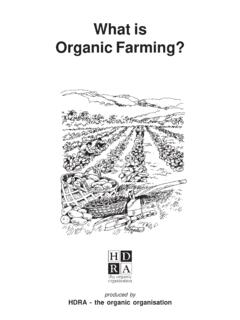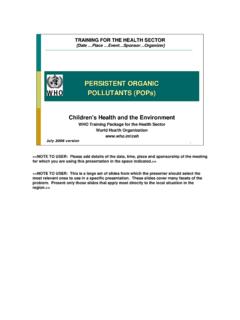Transcription of Research Children’s Health - Chem-Tox.Com
1 Environmental Health Perspectives volume 119 | number 8 | August 2011 1189 Research | Children s HealthOrganophosphate (OP) pesticides are widely used in agriculture, and several are registered for home garden use [ Environmental Protection Agency (EPA) 2006]. In 2010, 32 OP pesticides were registered in the United States ( EPA 2010). In 2007, 15 mil-lion kilograms of OP pesticides were used in the United States, representing 36% of all insecticides used (Grube et al. 2011). In California, million kilograms of OP pes-ticides were used in agriculture in 2008; the top five active ingredients were chlorpyrifos, malathion, phosmet, ethephon, and dime-thoate [California Department of Pesticide Regulation (CDPR) 2010].
2 OP pesticides have well-known neuro-toxic properties, with the primary mechanism of action involving inhibition of acetylcho-linesterase at high doses (Sultatos 1994). At doses lower than those needed to inhibit ace-tylcholinesterase, certain OP pesticides affect different neurochemical targets, including growth factors, several neurotransmitter sys-tems, and second-messenger systems (Slotkin and Seidler 2007; Verma et al. 2009).Most human studies showing adverse Health effects of OP pesticides have been carried out in occupational settings with high exposure levels (Kamel et al.)
3 2007). Children may experience chronic, low-level exposure due to historical home use, living near an agri-cultural field, and residues in food (Bradman et al. 2007; Lu et al. 2004). Children are at higher risk for pesticide toxicity than are adults because the developing brain is more susceptible to neurotoxicants and the dose of pesticides per body weight is likely to be higher in children (Weiss 2000). Children also have lower activity and levels of enzymes that detoxify activated forms of certain OP pesticides (Holland et al.
4 2006).Epidemiologic studies suggest that pre-natal exposure to OP pesticides is associated with poorer neurobehavioral development in infants (Engel et al. 2007; Young et al. 2005) and toddlers and preschoolers (Eskenazi et al. 2007; Handal et al. 2008; Rauh et al. 2006). Postnatal OP exposure has also been associated with behavioral problems; poorer short-term memory, executive function, and motor skills; and longer reaction time in chil-dren (Bouchard et al. 2010; Grandjean et al. 2006; Rohlman et al. 2005; Ruckart et al. 2004). Few studies have assessed exposure to OP pesticides both prenatally and during Center for the Health Assessment of Mothers and Children of Salinas (CHAMACOS) study is a birth cohort study investigating pesticide and other environ-mental exposures and the Health of pregnant women and their children living in an agri-cultural community.
5 Our findings suggest that most maternal pesticide exposure prob-ably occurs through the diet, as is the case for the general population, but with addi-tional residential nondietary exposure most likely from ingress of pesticides from agri-cultural use into homes (Harnly et al. 2009; McKone et al. 2007). Previous reports on the CHAMACOS cohort suggested that prena-tal, but not postnatal, exposure to OP pesti-cides was associated with increased odds of pervasive developmental disorder and lower scores of mental development at 2 years of age (Eskenazi et al.)
6 2007), and with poorer atten-tion skills as well as hyperactive behaviors at 5 years of age (Marks et al. 2010). It remains unclear whether cognitive deficits associated Address correspondence to B. Eskenazi, Center for Environmental Research and Children s Health , School of Public Health , University of California Berkeley, 1995 University Ave., Suite 265, Berkeley, CA 94704 USA. Telephone: (510) 642-3496. Fax: (510) 642-9083. E-mail: u p p l e m e n t a l M a t e r i a l i s a v a i l a b l e o n l i n e ( via ).We thank the CHAMACOS staff, students, com-munity partners, and participants and families, with-out whom this study would not be possible.
7 We especially thank the CHAMACOS field office staff as well as N. Holland and biorepository staff for their assistance in specimen management. This publication was made possible by Research sup-ported by the following grants to (principal inves-tigator): RD 83171001 from the Environmental Protection Agency (EPA), P01 ES009605 and R01 ES015572 from the National Institute for Environmental Health Sciences (NIEHS), and R01 OH007400 from the National Institute for Occupational Safety and Health (NIOSH). The contents of this article are solely the responsi-bility of the authors and do not necessarily represent the official views of the NIEHS, NIOSH, National Institutes of Health , or has consulted in a case of pesticide exposure.
8 The other authors declare they have no actual or potential competing financial 8 November 2010; accepted 13 April Exposure to Organophosphate pesticides and IQ in 7-Year-Old ChildrenMaryse F. Bouchard,1,2 Jonathan Chevrier,1 Kim G. Harley,1 Katherine Kogut,1 Michelle Vedar,1 Norma Calderon,3 Celina Trujillo,1 Caroline Johnson,1 Asa Bradman,1 Dana Boyd Barr,4 and Brenda Eskenazi11 University of California Berkeley, Center for Environmental Research and Children s Health , School of Public Health , Berkeley, California, USA; 2 CHU Sainte-Justine Research Center and Universit de Montr al, Department of Environmental and Occupational Health , Montreal, Quebec, Canada; 3 Center for the Health Assessment of Mothers and Children of Salinas (CHAMACOS), Clinica de Salud del Valle de Salinas, Salinas, California, USA.
9 4 Emory University, Rollins School of Public Health , Atlanta, Georgia, USACo n t e x t: Organophosphate (OP) pesticides are neurotoxic at high doses. Few studies have examined whether chronic exposure at lower levels could adversely affect children s cognitive j eC t i v e: We examined associations between prenatal and postnatal exposure to OP pesticides and cognitive abilities in school-age t h o d s: We conducted a birth cohort study (Center for the Health Assessment of Mothers and Children of Salinas study) among predominantly Latino farmworker families from an agricultural community in California.
10 We assessed exposure to OP pesticides by measuring dialkyl phosphate (DAP) metabolites in urine collected during pregnancy and from children at 6 months and 1, 2, , and 5 years of age. We administered the Wechsler Intelligence Scale for Children, 4th edition, to 329 children 7 years of age. Analyses were adjusted for maternal education and intelligence, Home Observation for Measurement of the Environment score, and language of cognitive s u l t s: Urinary DAP concentrations measured during the first and second half of pregnancy had similar relations to cognitive scores, so we used the average of concentrations measured during pregnancy in further analyses.







